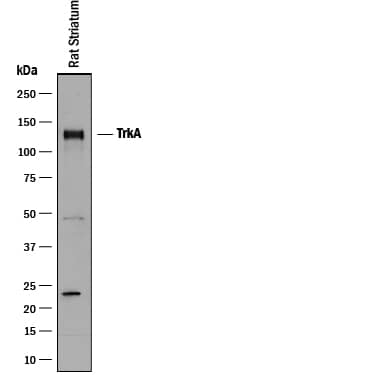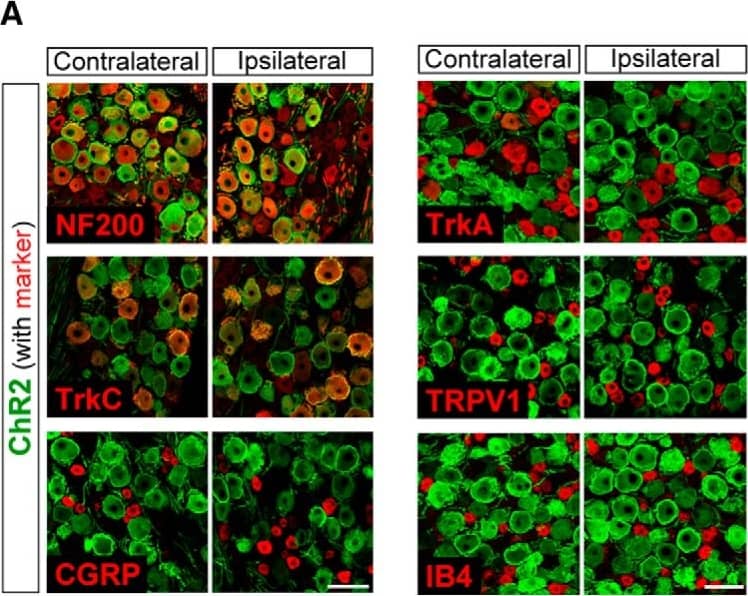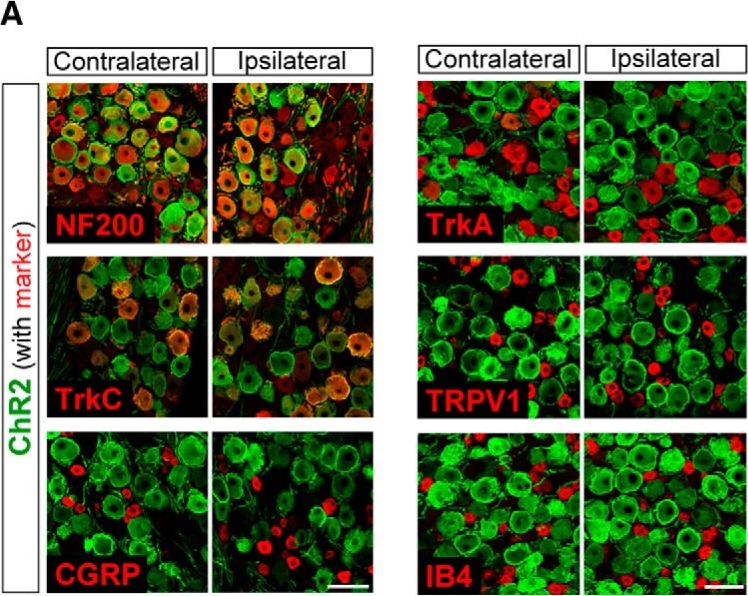Rat TrkA Antibody
R&D Systems, part of Bio-Techne | Catalog # AF1056


Key Product Details
Species Reactivity
Validated:
Cited:
Applications
Validated:
Cited:
Label
Antibody Source
Product Specifications
Immunogen
Ala33-Pro418
Accession # P35739
Specificity
Clonality
Host
Isotype
Scientific Data Images for Rat TrkA Antibody
Detection of Rat TrkA by Western Blot.
Western blot shows lysate of rat striatum tissue. PVDF membrane was probed with 1 µg/mL of Goat Anti-Rat TrkA Antigen Affinity-purified Polyclonal Antibody (Catalog # AF1056) followed by HRP-conjugated Anti-Goat IgG Secondary Antibody (Catalog # HAF017). A specific band was detected for TrkA at approximately 140 kDa (as indicated). This experiment was conducted under reducing conditions and using Immunoblot Buffer Group 1.TrkA in Rat Dorsal Root Ganglion.
TrkA was detected in perfusion fixed frozen sections of rat dorsal root ganglion using 15 µg/mL Rat TrkA Antigen Affinity-purified Polyclonal Antibody (Catalog # AF1056) overnight at 4 °C. Tissue was stained (red). View our protocol for Fluorescent IHC Staining of Frozen Tissue Sections.Detection of Porcine TrkA by Immunohistochemistry
Immunohistochemical characterization of ChR2-expressing DRG neurons. A, Immunolabeling of ChR2+ neurons (Venus; green) with either NF200, TrkC, CGRP, TrkA, TRPV1, or IB4 (red) in the L4 DRG contralateral and ipsilateral to PNI on day 14. B, Percentage of colocalization of each marker in ChR2+ DRG neurons [n = 4 rats (two to three slices per rat)]. Size-frequency histogram (inset) illustrating the distribution of the cross-sectional areas of ChR2+ NF200+ DRG neurons in the L4 DRG ipsilateral (371 cells) and contralateral (316 cells) to PNI on day 14. Values represent mean ± SEM. Scale bar: 100 μm. Image collected and cropped by CiteAb from the following open publication (https://pubmed.ncbi.nlm.nih.gov/29468190), licensed under a CC-BY license. Not internally tested by R&D Systems.Applications for Rat TrkA Antibody
Immunohistochemistry
Sample: Perfusion fixed frozen sections of rat dorsal root ganglion
Western Blot
Sample: Rat striatum
Reviewed Applications
Read 2 reviews rated 4.5 using AF1056 in the following applications:
Formulation, Preparation, and Storage
Purification
Reconstitution
Formulation
Shipping
Stability & Storage
- 12 months from date of receipt, -20 to -70 °C as supplied.
- 1 month, 2 to 8 °C under sterile conditions after reconstitution.
- 6 months, -20 to -70 °C under sterile conditions after reconstitution.
Background: TrkA
TrkA, the product of the proto-oncogene trk, is a member of the neurotrophic tyrosine kinase receptor family that has three members. TrkA, TrkB, and TrkC preferentially bind NGF, NT-4, and BDNF and NT-3, respectively. All Trk family proteins share a conserved complex subdomain organization consisting of a signal peptide, two cysteine-rich domains, a cluster of three leucine-rich motifs, and two immunoglobulin-like domains in the extracellular region, as well as an intracellular region that contains the tyrosine kinase domain. Two distinct rat TrkA isoforms (TrkA-I and Trk-A-II) that differ by a 6-amino acid insertion in their extracellular domain have been identified. The longer TrkA isoform is the only isoform expressed within neuronal tissues whereas the shorter TrkA-I is expressed mainly in non-neuronal tissues. NGF binds to TrkA with low affinity and activates its cytoplasmic kinase, initiating a signaling cascade that mediates neuronal survival and differentiation. Higher affinity binding of NGF requires the co-expression of TrkA with the p75 NGF receptor (NGF R), a member of the tumor necrosis factor receptor superfamily. NGF R binds all neurotrophins with low affinity and modulates Trk activity as well as alters the specificity of Trk receptors for their ligands. NGF R can also mediate cell death when expressed independent of Trk.
References
- Esposito, D. et al. (2001) J. Biol. Chem. 276:32687.
- Sofroniew, M.V. et al. (2001) Annu. Rev. Neurosci. 24:1217.
Long Name
Alternate Names
Gene Symbol
UniProt
Additional TrkA Products
Product Documents for Rat TrkA Antibody
Product Specific Notices for Rat TrkA Antibody
For research use only


